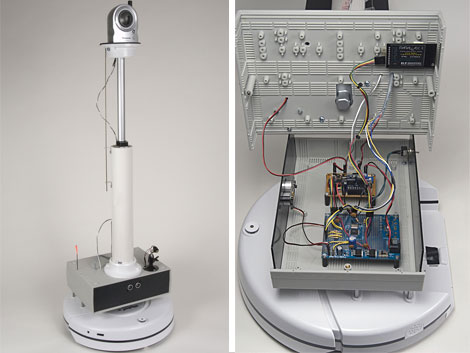You don't have to live in a Jettsonian's retrofuture to enjoy the luxury of robot servitude; plenty of DIY robotics projects exist to take over the more burdensome aspects of your life. These DIYers created their own robots to fulfill a range of functions, from shoveling snow in –40°C weather to monitoring the home via a mobile platform.
RoboCam Mobile Camera Platform
Created by hobbyist Steve Norris, this telepresence robot serves as the eyes and ears around the home whenever the family is away. RoboCam is piloted remotely via a web server accessible through a laptop, and is equipped with both proximity and cliff sensors, to avoid collisions. A laser pointer mounted on the robot shines a red dot 3 feet ahead to aid with depth perception.

RoboCam's uses a standard webcam, mounted on a 2-foot-long PVC pipe – it stands a total distance of three feet from the ground. The base of the robot is actually an iRobot Create, reprogrammed by Norris to automatically parks itself in the charging base whenever his home recon is finished.
Snowbot
Chris Baird, of Digi-Key's Design Support Services, created the Snowbot to shovel his driveway during the harsh winters of northern Minnesota. Wirelessly controlled, and features four onboard cameras, a video transmitter and switcher, along with high-powered LEDs.
Snowbot’s uses a main drive motor salvaged from another piece of equipment, and requires 24 volts to operate. Two large lead-acid batteries connected in a series provide the juice to spark the motor, but also add weight to the machine. The robot must be heavy enough to actually push the snow.
Not all the systems on-board use 24 volts to operate; the motors used for lifting and rotating the blade, some of the electronics supporting the main drive motor, along with all the camera, video, and LEDs, all require 12 volts. If everything were to be connected to the two batteries, they discharge unevenly and render the pack unbalanced. Recharging them would take twice as long or require two separate chargers. As a more practical solution, Chris chose to use a high-power DC/DC 200-watt power supply, allowing him to run the entire 12-volt load off the 24 volt batteries and charge them with a single 24-volt battery charger.
RoboStool
Another one of Steve Norris' creations is the RoboStool; a little robot tasked with the job of following people around and ensuring their feet are propped whenever they sit down. In other words, RoboStool is not actually a stool, but rather a mobile foot rest.

RoboStool uses a simple foot rest purchased from Bed Bath & Beyond.
Navigating by way of remote control alone is boring, so Norris equipped RoboStool with two additional navigation systems: one is a thermal sensor allowing the machine to pursue heat signatures, and other uses infrared beacons to create a waypoint path. For the purpose of collision prevention, sensors similar to the RoboCam are installed.
The availability of vast amounts of free information on the Internet, coupled with open-source technology permits anyone with a curiosity and willingness to learn the ability to build their own robots. Being an engineer is not strictly necessary.
Visit TechXchange to share your DIY project ideas and obtain community support.
Advertisement
Learn more about Digi-Key





